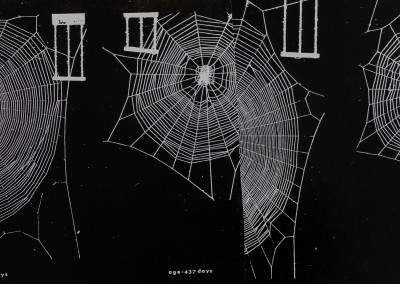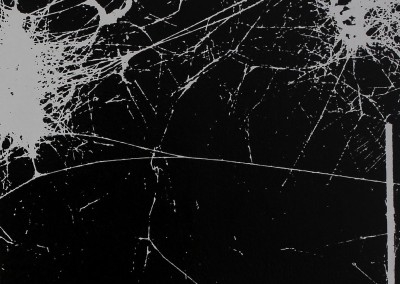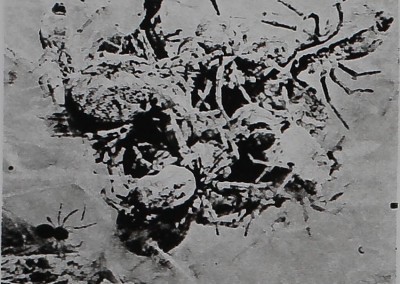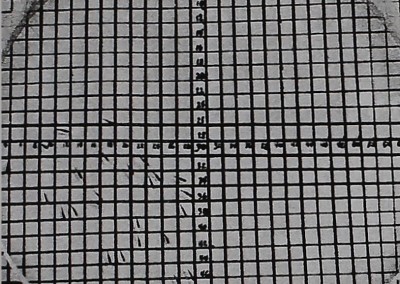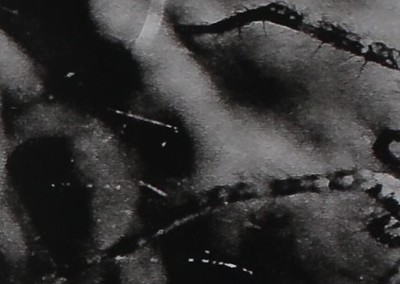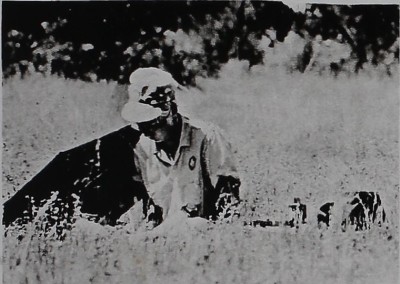Images Collection
Read OCR Digitized Article Text
NOTE: This plain text article interpretation has been digitally created by OCR software to estimate the article text, to help both users and search engines find relevant article content. To read the actual article text, view or download the PDF above.
The earth is literally crawling with spiders. Some 30,000 species have been tallied to date, and the guess is that half as many more still await discovery. Yet, despite their abundance and their ubiquity, spiders—members of a class of organisms called arachnids that, also includes ticks, mites, scorpions and daddy longlegs—were long presumed to be little more than evolutionary relics. The prevailing notion was that spiders were ecologically irrelevant, vestigial threads in the web of life.
“When researchers looked in the past,” says arachnid ecologist Susan Riechert of the University of Tennessee, “they concluded that spiders were ineffective regulators of the insect populations because they failed to increase their own numbers in response to increasing prey populations,”. With that verdict of insignificance, it was hardly surprising that arachnologists studying the spider kingdom traditionally confined their pursuits largely to the realm of systematics or taxonomy, the business of identifying creatures according to family, genus, species, etc. Trifling significance was attached to research efforts inquiring into the biodynamics of spider behavior or their role in ecological systems.
But in recent years this view has come in for considerable revision. New breeds of arachnologists have emerged—arach-nologist-cum-behaviorist and arach-nologist-cum-ecologist—specialists concerned with what spiders do, and where and how. And out of this pair of new research foci, among others, is coming evidence that has all but demolished the supposition of spider irrelevance. Far from being trivial, spiders are now believed not only to be critical contributors to the balance of countless terrestrial ecosystems but to be a superlative form of invertebrate life on earth as well. To Peter N. Witt, a 30-year veteran of spider investigation, the complexity of spiders’ neurally programmed behavior, as reflected in the orb or cartwheel web, is the ultimate expression of superior, highly integrated invertebrate brain function.
Not all spiders build webs. Of the 30 to 50 families known, perhaps’ half don’t. Many are insect trackers, vagrant predators. One such, the tarantula, is the most, primitive spider of all. Spiders, nonetheless, conjure in most minds the image of intricate webs.
Different species weave different kinds of webs. But generally the architecture
fMHH
the Top Arachilia ”
Spider experiments. Behaviorist Peter M. Witt, working with Araneus diadematus, finds that spider webschange with the spider’s age and that drugs have an impact. The web at the far right, reflect the influence, of amphetamines, is compared to the adjacent normal web.
Peter Witt

Social spiders.SShe Mexican groufpiolerant spiders-, Mallos g re galls (left)^|||s®en mássé in a laboratory web (top right). The weScompl#x spider, Metepelra spinipßs, build! orb webs (above) in close proximity tp’.®ih othert ABoximity grid (right), applied to other species as well as^spiders^uggesM prinCiples ability.
J. W. ípi rgeés^^hn^ll^.ury
Fits one of three basic blueprints: the sheet web (a two-dimensional structure showing no symmetry, the threads crisscrossing each other in apparently helter-skelter fashion), the space web (a scattered, three-dimensional, multilevel arrangement) or the geometric orb (the familiar two-dimensional cartwheel). The ultimate web—the most material- and labor-efficient and most effective in snaring prey—is the orb web, says Witt, a behavioral scientist who heads the North Carolina Department of Mental Health Research in Raleigh.
Cephalization and economy Web spinning, which calls for many ntegrated behavioral functions, bespeaks a highly developed central nervous system. In fact, if brain volume and neuronal density are keys, Witt contends, then spiders are probably the most advanced
Ípecies on the invertebrate evolutionary «dder. “As animal species grow more mplex,” Witt observes, “there is in-: a sed cephalization Iconcentration of
important functions in the head]. In man, the number of nerve cells in the brain far outstrips that seen elsewhere in the nervous system. In spiders, cephalization is even more concentrated than in man.” Among spiders, orb webbers, of which some 6,000 species are known, may have the most highly developed brain function, since the orb web is the most patterned, the most preprogammed expression of an exquisitely exacting blueprint written in the genes.
There is no generation-to-generation teaching of web spinning among spiders; newborn spiderlings don’t see their parents. For it to survive, a spider must spin a letter-perfect web from the outset. There is, however, some flex in the program, some plasticity, as Witt discovered when he took a spider out of ||s web midway through eoi^truc^6P<? drained it of its silk and then replaced it. The spider immediately picked up where it had left off. But it adapted to its own material depletion by finishing the web with abnormally wide spacing between
spirals.
Poor vision seems to go along with web spinning; spiders need their webs to extend their sensory and capture range. To show the importance of the web to spider survival, Witt performed a series of near-starvation studies on his research favorite, Amneus diadema!us, the orbspinning corn spider commonly found in New England and many parts of Europe. When deprived of food, A. diadematus does not spin a smaller web as a means of conserving its protein resources. ,Np;r does it build a larger-than-normal structure as a last-ditch effort to increase capture capability. Instead, in Witt’s experiments, every morning A. dmianutus continued to build its web to exactly the same dimensions as it had prior to the days of famine. To obtain the necessary protein for silk, it borrowed protein from itself—losing weight in the process. Even when it had shrunk to half its size, it still 1 spun a full-size web, but with a wider 1 mesh. Only after six weeks of starvation 1 did web size begin to shrink. Even then 1
highly refined statistical techniques.
Over the years Witt has gotten so good at identifying webs that, if any of his charges moves from one part of the laboratory to another, he can tell at a glance where it has taken up residence. He can also tell, just by looking, how old the spider is; web cha rae te r is t ips are age dependent.
Of the 6,000 or so orb-web species that ha vie been identified, all, follow pretty much the same behavioral pattern: each builds a new web every day—a task that generally takes less than a half hour to complete. The silk for web manufacture emanates from spinnerets, valveiike structures on the posterior portion of the spider’s abdomen. Most spiders can spin several kinds and thicknesses of silk^aii Rafiy a^eyén j||some cases. Not all of it goes for web spinning. Some may go for the production of a drag line to provide the spider with transportation, for wrapping prey, for lining a burrow or shelter or fer en(flosing egg sacs in cocoons.
The spiders build their webs modularlv.


the spider never missed a day building. (Witt never seeks to stress spiders to death in his experiments. “I love these creatures, and that would break my heart,” he says.)
Even among members of the same species—or the same litter—no two spiders build to exactly the same orb design. “Each web is tike a person’s face, fingerprint or signature—unique,” Witt explains, having established this singularity only after ten years of pains-:aking analysis of web construction.
The task required the identification of 1,000 distinct points on the web (where A. Uadematus fuses thread to thread), measurement of thread angles and distances between spirals, quantification of shape (e.g., whether the web was longer :han wider and by how much), tallying of :urning points (where the spiral changes direction between radials), evaluation of entricity (how symmetrical the web is), he development of a complex computer •rogram (which in itself took three years o elaborate) and the application of some

with each of the several thousand meshes the product of a specific, short behavior sequence. The web. features a hub area where the spider rests and lies in wait, its legs grasping the radial threads. An adhesive substance on the spiral enhances prey capture. A fly snared by the spiral sets up llbraipm® in the web, with H radials serving to signal the location and heft of the trapped prey. The spider must act quickly; a fly can unglue itself in two or three seconds. Scrambling from its headquarters in the1 h«j the spider Immobilizes its catch with paralyzing bites or by wrapping its find with silk. (Spiders, though they are predators, subsist on a completely liquid diet. They use their mouthparts to lacerate their insect prey. Then enzymes from the midgut pour out over the torn tissue, producing a broth that can be sucked up into the stomach.)
Web building is a model of economy and energy conservation. Orb spinners, for instance, actually eat their webs every night and use more than 90 percent of the recycled silk in the construction of a new
web—not the next day, but 48 hours later. This was demonstrated by in
collaboration with David Peakall, a biochemist, then at Cornell University.
In their experiments, Peakall and Witt fed A. diademalus radioactively tagged alanine, the principal amino acid in web protein, prompting the spiders to weave a “hot” web. The original spiders were then removed and “cold” spiders placed on the hub in their stead. Forty-eight hours later the new spiders, having eaten the webs to which they had been moved, were spinning the ingested, radioactive alanine into their own webs. The 24-hour delay means the spiders have a whole other supply of silk protein to get them through the next day’s architectural chores.
Most ¡¡¡»he energy required Tor web building is expended in the steps the spider takes in moving about, tying the pieces together. Thus, the entire energy investment—”step” energy plus new-silk synthesis—is very small, amounting to what the spider derives from one or two flies. The rest of the spider’s energy store goes to predation and reproduction.
Loners
Like most spiders, orb spinners lead solitary lives. The spider builds the web for its own use and brooks no encroachment. “Anything that touches the web is treated aggressively, as prey,” says Witt. He demonstrates this by buÄmg, a vibrating tuning fork against the web. The spider tenses and attacks.
PflfBly life, among liter-
mates, is there any semblance of tolerance among A. diademalus. Several hundred newborns, miniature editions M adults, emerge simultaneously from the mature egg cocoon (placed by the mother weeks or months earlier a distance away from her own web). These spiderliggs almost immediately begin to lay threau’as they move. Within a few days, their combined peregrinations have produced a sheetlike while lacking añfl apparent geometry, serves the spiderlings as a communal web.
The spiderlings may collectively attack any smalljpiey |fea|)catches on the web and wräpifpd Intruder 1® silk. But atllMf early stage spiderlings won’t feed on thlSr captive; they live instead on the remaining folk supply in their abdcfmins.
Gradtaalls’Vylih each siñ®eed¡ng molt, the spiders grow more aggressive toward réadh other. th^Bird and last molt, some two or three weeks after hatching, the tolerant” phase is finished. The spiderlings simultaneously get read¡yg¡3 disperse, leaving the communal web
aerially, through a process called ballooning. At the appropriate time, depending on atmospheric conditions, the now-arachnophobic spiderlings each dangle a thread of silk for capture by the wind, and off they soar. Alighting wherever the breeze deposits them, the spiders actively seek out sites to spin their first, flawless, orb webs. (Ballooning is a treacherous business, which probably explains why so many more eggs are produced by wind-scattered species than by species whose spiderlings disperse along the ground.)
ff spiders are such aggressive, sometimes cannibalistic loners, how do they manage to mate? (To borrow an old punch line: Very carefully!) Mating is a risky proposition for the male. If the female is not receptive, she can do the male serious, even mortal injury.
Not surprisingly, the courtship may last hours or days. It begins weeks before full maturity, when the male stops web building and sets out to hunt for a female over wide distances.
Apparently the male can tell, from the nature of the web, which female is mature. Once the male discovers a potential mate, it fastens a safety thread—literally a getaway line—to an anchorage outside the web. His escape route established, the male makes his presence and intentions known by drumming on the web in a characteristic pattern. Sometimes the male may even bring a gift—an insect wrapped in silk, for instance. These preliminary approaches fflláMIISve to be repeated many times, interrupted perhaps by the male swinging awá^Jft®íí|;, the web outopl the female’s potentiallft dangerous clutches. It is not known what makes a female receptive to ppé Balppgl another or at one time or another. ¡Pheromones—scent signals— are pm^gs^^ssimaj^^sa being investigated. But cues to whats-more than whim is certain to be i>nvolved^§||piftifl a mystery.
The behaviorist
For fhe last dozen years.fpll has based his spider laboratory at the state mental hospital in Raleigh. Invariably, this ap-Ipareni ^^^^^SM^; raises eyebrows. What, áÉBH&ifc is a trájÉMgmfiilóiait-pharmacologist and a practicing director heaiithdoing in arachin;@Ji^&? On closer inspection the connection is really no;t at all illogical and is, irtCjäct, clinicJflga relevant.
began in 1948 when ¡Witt, a íÍIrHÍ pharmacologist at the University » Tubingen, was approached by Hans M. meters, 111 tqaitemmHMBB–
man zoologist who was affectionately known as “the spider web man.” Peters was gager ft© make a movie about web building. But he was stymied by the fact that his spiders built their webs at 4 A.M., when ambient light for filmmaking was lacking.
Peters asked Witt to se.e iiT Ihe could come up with a drug that would shift webbuilding activity to a later, more convenient time. Witt gave various stimulants and sedatives a try. All failed to alter the time of construction, but they did elicit some unexpected behavioral changes. Under drug influence, the spiders wove strangely deranged webs.
Discouraged, Peters forsook the film ■project. By then, however, Witt had become intrigued, pouncing on the idea of using webs as a laboratory model for testing and understanding the effects of hallucinogens and Other drugs. And so spiders became a major avenue of Witt’s research pursuits.
“Animal models are indispensable to the study of mental aberration. Animal models give us a chance to get our hands on some hard, objective measures,” says Witt. “People are much too individualistic and unpredictable, in their responses, so the results [of observing humans] can often be confounding.” For instance, Witt found, the spider web offers a powerful visual analog of hallucination, providing an effective means of screening agents for their mind-distorting potential.
A few years ago—upon reporting on his spider/drug experiments and publishing some striking photographs of the wild webs woven under the influence of LSD, amphetamines, marijuana and caffeine— Witt received a considerable amount of exposure in the world press. He still hears from individuals seeking help for their mentally troubled relatives. One mother recently wrote to ask if feeding spiders to her schizophrenic daughter would help *° 8et a«d, if so, which species were best. Wilt responds sympathetically. He understands, of course, t«fe?^^i® reaching out: i@r any possible jremedyij’^^ matter teOftynoutlandish, his correspondents are really demonstrating a H^Äfftate need any heater
f^fdwteh iftf lfee ibfcto respond.
Social spiders
Witt’s clinical orientation has led him in ‘T*e©ep!ft féSj§s| t©>f exipaifedö the research; purview of his labora^ry so that now it en^Sgds a »h®Ife ©fther kind of spider species. This species jPa|Sfesffe“á¡a altogether rare the spider
kingdom: sociability or group living.
14 MOSAIC November/December 1978

Much of the impetus for this line of ■ inquiry came from the presence on the , research staff of J. Wesley Burgess, a f biologist-cum-behaviorist who, under ; Witt’s tutelage, made social spiders his. I special province.
Of the 30,000 spider species known, j only 33 show any signs of tolerant : communal behavior in adult life. But even among many of these ostensibly social , types, certain qualifications are in order.
; Metepeira spinipes, for instance, constructs t an orb web for solitary dwelling. But the Í orbs are commonly distributed as a larger, interconnecting, three-dimensional space ‘ web, shared by many spiders. With each (spider on its own piece of the shared
• structure, M. spinipes coexist peacefully; j but it’s an entirely different story should
* any individual step over the boundary onto another’s orb..
But there- are six truly communal < species. Because they are Unrelated and j live bri six different .continents, Witt i believes, it is safe to assume that spiders ,i “invented societal living six times over.” (Each of these social species inhabits ¿tropical and subtropical locales where 5 there is often an abundance of insect (fodder.
For the longest time, social spiders were ¡all but ignored by investigators. A few papers were published at the turn of the pcentury, “the last decent one” in 1910, (according to Witt. Not for, another six ¿decades was anything more seen in the (scientific journals about these unusual ¿species. But since their rediscovery in the (late nineteen-sixties,, when a paper •appeared on spider sociality written by ¡Ernst Kullman of Cologne, an animal ■behaviorist, interest has stepped up considerably.
Burgess, Witt’s behaviorist associate, ¡has concentrated his studies chiefly on j Mallos gregal is, the gregarious spider, a ¡Mexican .inhabitant that also thrives in •the laboratory in Raleigh. M. gregalis ¡builds a large, permanent, central web ■that continues to increase in size as young members of the colony lay new thread, j Web inhabitants may number in the •thousands. Multitiered, the web has an adhesive surface for prey capture, a complex network of interior tunnels and passageways and chambers in which eggs are stored and spiders rest.
M. gregalis measures an average body length of five millimeters and weighs only about one-twentieth as much as most orb-spinning spiders. By combining labors, however, a colony of social spiders is able to construct a web much larger and
more elaborate than the web of any related solitary spider. The cooperative effort also means that little energy is expended by any one colony member.
To Mexicans in the countryside around Guadalajara, M. gregalis is known as el mosquero, the fly killer; they commonly adopt the spider to help control the pesky fly population, draping their homes with web-covered branches that serve as a natural flypaper. The spiders’ usual quarry, houseflies and blowflies, at 20 to 30 milligrams each, are considerably larger than the biggest adult M. gregalis female, which weighs between 2 and 10 ■ milligrams; predation works because the species fiiftacks its prey in large groups.
of Burgess’s main lines if inquiry has been to determine how social spiders have mah-agedS^j fsprate each other. Thqügh almist anything else (Sac, apr Bpopriate siz’e-í^even ‘ other spidersSjia fair game, M. gregalis Somehow is not aggressive toward its own kind.
The web as signal processor
What accounts for the tolerance? What enables them to distinguish each other from prey? The answer lies in the web, says Burgess. M. gregalis, like most web-spinning spiders, has spoor vision, so vibrations along the silken threads are probably the principal means of information transfer and the key to aggressive vs. jfolerant behavior.
In one set of experiments, Burgess placed several kinds of prey in the web: anesthetized houseflies, flies with immobilized wings, small and large cockroaches and normal flies. Nonbuzzing prey were virtually ignored by the Colony. If a single spider accidentally touched or. came near such quiet prey, it might approach and feed individually. But no group predation was evident.
Events were decidedly different, however, when an experimentally untreated •fly got stuck in the web. It respondM ift® its ¡pfiftdicament Sy buzzp^foudly. The buzzing abruptly changed: the spider behavior. Typically, a number emerged from the intén®:§i?í the j^mbis^Bwited themselves by a series of jerky jumps and sped straight for the haplesa». If ;fhe Ihpzzing stopped for a moment or the fly managed to escape, the spiders stopped dead in their tracks. They became active again if the buzzing resumed.
The spiders attacked the prey as group. This set the fly to buzzing all the more, causing s«gBSlÍB*.,-‘sÉ^feest ini-eluding immature spiderlings, to scramble to the scene. Soon the prey disappeared under a pile of feeding spiders.
What was it about the buzzing that set the spiders off? Burgess was able to show that M. gregalis’s web does not have a “flat” audio response; the web is not a faithful transmitter of all frequencies. Rather, it acts as a highly selective signal processor, suppressing some, enhancing others. At vibrations between 40 and 500 hertz (cycles per second), thei signals are significantly amplified. Vibrations below 40 and above 500 hertz are rapidly attenuated. Not surprisingly, the buzzing of the housefly produces a spectrum of vibrations in the web within the resonant frequency window between 40 and 500
In another set of experiments, Burgess used an electronic generator to send pure signals ranging from 10 to 100,000 hertz through the web. Only in the 40- to 500-cycle band was he able to elicit predatory behavior: the jerky turning and •the straightline scramble toward the signal teouWey*
This narrow cueing window may also explain tolerance and wBI absence of intraspecific predation. According to’ Burgess, spiders moving around on the web do not generate vibrations within the resonant band.
The attenuation of signal information outside the transmission window may serve another protective function, that of keeping the spiders away from dangerous creatures that might come into the web. For instance, the characteristic buzzing of a web-trapped honeybee is above a kilohertz. Such signals are quickly damped by the web, and no predatory behavior is observed. Thus, the attenuation quite often provides a mechanism for blocking approach to a creature that could do the spiders lethal damage.
Unlike most solitary spiders, M. gregalis does not use silk binding to immobilize its prey. Most web-building spiders, Burgess explains, will Wfd^^piAy items, conspe-fí éifics and intruders, indiscrim-
inateljy! The more straightforward orientation and attack pftiSiatS of M. gregti|jpg sharply limits the likelihood of aggression aÄOüg consjp^iges.
Studying sociability
To Burgess, the social spider serves asa an excellent model for seeking fundamental clues to very basic questions on tbe • evolution of social behavior in all species.;-, “Social spiders are a good place to look for apj|wd^s to the evolution of communal living since wé ha ve no real biases’afflu’tS them,” he sag&BHjp^gpk represtplfs a succesSM tradSp between social con-cessions and mutual benefits to form an
interdependent, self-perpetuating colonial system.”
Burgess contends that there are not only species-specific solutions to the problem of living and hunting together, but general ones as well. The goal is to derive a methodology for evaluating interactions among spiders that can be applied to other life forms. “This way we can add to the knowledge of phylogenetic development in sociality and a better understanding of the variety of ways cooperation is possible,” Burgess says.
His latest investigations seek to determine the various means (chemical, vibrational, tactile) by which spiders in the web actively communicate and cooperate in prey sharing, courting, reproduction and the raising of offspring.
A recent observation is that the male has an advertising routine when he is ready to mate. He drums in a distinctive way on the web, alerting the entire web population. But only mature females heed the signal and approach.
Most recently, Burgess has been paying particular attention to a study of the distribution of social spiders on the web: how they separate themselves from each other. If there is measurable, reproducible spacing, he explains, then it must result from an active form of communication among the spiders. For these trials, Burgess sets up a camera to take time-lapse photos of the animals automatically. The slides are then projected onto a grid in the laboratory and, from the resulting coordinates, information is extracted on distances, distribution patterns and activity rates. The data are then processed by a computer.
So far, Burgess’s observations have confirmed that social spiders do indeed actively arrange themselves on the web. The spiders tend to cluster in units of three, expressed in terms of nearest and next nearest neighbors. By contrast, tests with solitary spiders showed them to respond to the presence of another spider by getting even more solitary, moving as far away as possible from their neighbors. Burgess has extended his spacing measurement technique to an analysis of aggregative behavior in rhesus monkeys, schooling fish, swarms of gnats and eóeteóá~ches|Cgj Ultimately, this methodology will be ‘ applied to an investigation of human aggregation in a varié® of such social settings as schools, airports or hospital wards. One potential benefit—and this is of special interest to Witt—would be ipi apply such knowledge to the design of the optimum mental hospital ward. “We’ve



Arachnid ecology. Dispersion of Agelenppsis aperta (left) differs -In New Mexican desert/grässs*. land environment (top) and Arizona desert creek bed «(bottom). The bottom web is seen .from the side;, its funnel-dips-into litter. A spacing experiment ’(above) disclosed A. aperta’s (crowding intolerance. At right, Susan Riechert watches spider feggr^s,iv^nteracti%rns while |m o n envliiiQnmeirM^
plndiitiffip’n south-Géitral New
Susan Riechert’

* 1 «
designed wards arbitrarily/’ says Witt, “without a shred of real scientific data about how humans prefer to live spatially.”
The ecological net As interesting as are spiders’ relationships to each other, as revealed by current behavioral research, they are also being shown to play an ecological role. That they help to regulate an ecosystem’s insect population should not be at all surprising. Nevertheless, biologists long rejected this idea, holding to the belief that spiders are ineffective as natural pest controls. The reason was that, in studied ecosystems, spiders did not show any population increase, the classical concomitant of intensified predation, in response to increases in insect numbers in the same region. Or at least no such response could be found.
It was a paradox, but without evidence to the contrary, spiders had to be classed as an ecological sport. That the spider is now being recognized as integral to ecological systems is largely the consequence *of research conducted by Tennessee’s Susan Riechert.
Riechert has been keeping tabs on several populations of Agelenopsis aperta, a solitary spider found predominantly in desert and grassland habitats in the Southwestern United States and Mexico. By carefully tracking spider movements, she has succeeded in turning up the “missing link” long presumed necessary before the spider could take its rightful place in the ecological web: the near-synchronous swing’in predator and prey population sizes that reflects predator response to prey availability. And why had this putative link escaped detection for so long? Because, Riechert explains, spider population dynamics are subtle and easily misconstrued. They are masked by a hitherto little-recognized behavioral attribute: fierce territoriality.
Territoriality “We know that territorial behavior is common among vertebrates,’^ says Riechert. “It’s not nearly so well recognized among invertebrates. But.it’s there all right. In fact, it’s widespread, but has largely been overlooked because invertebrates often employ subtle methods of territorial maintenance.”
In the case of A. aperta, the territory includes more than just the web—a relatively permanent sheet web that lasts weeks or months, with the spider adding to it daily. A. aperta polices an area beyond the perimeter of the web, intolerant of incursion even—or especially—by any conspecific. Riechert likens the web to a corral and the territory outside the web to a ranch with fence:nes. (To complete the analogy, there’s also a “ranch house,” a funnel built into the web, where the A. aperta positions itself.)
Dramatic confirmation of territoriality came from a series of experiments in which 16 A. aperta were compelled to build webs inside individual, regularly spaced metal cylinders. The cylinders were set in a screened-in area normally occupied by just two spiders. Once the spiders established their webs, Riechert removed the cylinders. It wasn’t long before territorial disputes erupted. Within 14 days, the number of spiders in the enclosed area had been reduced to two. (The other 14 had been killed, since escape was impossible; normally, in true field circumstances lacking an artificial enclosure, the subordinate spiders would generally clear out rather than engage in combat.)
The results in many trials were the same, regardless of whether the crowded spiders were fed to saturation, fed what they would probably get under natural circumstances or held to starvation levels. In all cases only two remained in a two-spider-sized habitat.
In the natural habitat, A. aperta actively seeks out the best web site. Riechert thinks they locate potential sites on the basis of air vibrations set off by flying insects. Such vibrations are thought to be picked up by tarsal slit organs, eardrumlike structures on the spiders’ legs, and trichobothria, fine, sensory hairs running along the end portion of the body.
In many instances, choice web sites are limited, leaving many spiders without a good place to settle. Based on her observation of the movements of more than 200 physically tagged A. aperta, Riechert estimates that, at any given time, in any given habitat, at least five percent of the spider population is on the prowl for new sites. As such, the likelihood of a spider encroaching on an already occupied web site is very high. Often, a newcomer will seek to oust the occupant. Generally, the spoils—the web and the territory—go to the heavier of the two combatants. In most instances, the battle is more feints and bluffs than actual fighting. When the differences in size are small, the resident
•red to win because of web-site y. “Think of it as home-court age,” says Riechert; “the inhabi-iows better than the challenger iod the site is and what it’s fighting itain.%’4f
»mparing eight different A. aperta tions, Riechert found that web and ry size are a function of prey ility and habitat. Not unexpected-ere prey density is greatest, web ;rritory size are smallest. For :e, those A. aperta inhabiting an rich orchard in southern Mexico in territories a twentieth the size >e maintained by A. aperta in a far tod-abundant New Mexican lava
atic conditions also play a role; ry size increases with increasing e and climatic severity of the site, irgest territories are maintained time for prey capture is limited by rature extremes. (Metabolic ses of A. aperta are most efficient at ratures ranging from 21 to 35 s centigrade.) Given the same e, A. aperta holds a larger territory thermally stressful lava bed than a avorable grassland habitat, hert concludes that web and ry size are fine tuned to prey »ility minima over an average of six m years. Thus, in good times, when density is high, A. aperta doesn’t d by diminishing territory size, step would allow more A. aperta to ite the space and create future tition. Instead, it spends less time in ipture. Come the bad times, then, ere will still be enough food to tee survival.
tionally, when conditions are fa-?, the spiders increase their output i. Usually A. aperta females produce 100 eggs per sac. If it gets more it will lay more eggs. (In the lory Riechert found that females, abundance, would lay as many as egg sacs in a breeding season.) i then; at last, was the long-sought ig link”: More insects mean more nd do indeed mean more spiders, lere was also a catch: Because of riality, population size within a habitat would not show the ex-density increase. The most fit lin established territories . in the 3t sites; others leav^flthe habitat/ to build webs on the less desirable rts, enlarging the range in the s.
hert suggests that this well-ted territoriality provides another
ecological advantage: species richness. That’s important, since no one species could fully utilize all the available food (or regulate the full spectrum of insect species). In one prairie site, for instance, Riechert counted 307 different spider species in the same habitat. The implication here, says Riechert, is that the high intra-specific competitive interactions and territorial disputes probably limit interspecific competition among spider communities, thus allowing sizable niche overlap. She is currently investigating in greater detail the role of and relationships within spider communities made up of many spider populations.
To Riechert, the story comes down to¡ this: It is the fairly constant density of | individual spider species, plus the broad species composition in any given habitat, that works to maximize the spider’s role as insect buffer. It is not, as investigators j once theorized, simply a matter of prey- j related shifts in spider density.
Basing her contention on these new} observations, Riechert suggests that spiders can be adapted by man to serve as natural controls in certain vulnerable i areas. Ironically, chemical pesticides often have been much more effective in dislodg- j ing the native spider population than in destroying ravaging insects. Her idea will ¡ soon be put to its first experimental trial; f William Whitcomb, a zoologist at the University of Florida in Gainesville, plans to introduce spider groups into an agricultural research station to see if the effort will help protect tall timber.
In the Memoirs of Sherlock Holmes, Sir ; Arthur Conan Doyle has his master detective make these remarks as he examines the evidence in a new case: “We are suffering from a plethora of surmise, í conjecture and hypothesis. The difficulty is to detach the framework of fact…from the embellishments of theorists and j? reporters. Then, having established ^ ourselves on this sound basis, it is |||r duty to see what inference may be drawn , and what are the special points upon P which the whole mystery turns.”
To Peter Witt, who is fond of that Doyle quote, “Spiders have been much-maligned victims of this ‘plethora of | ■ surmise'” in the absence of much hard and 1 fast data about their true living habits. But all that is changing now as a new breed of arachnologists takes to looking at the “special points upon which the whole mystery turns.” •
The National Science Foundation contributes to the support of research reported in this article through its Psychobiology and Ecology Programs.

